Last Friday in Kasoaka, Japan, Taizo Sano opened the new greenhouse of SARA Inc. The new 18.5-hectare facility includes a 13-hectare greenhouse in which peppers, tomatoes and lettuce will be grown. It’s not only the largest single-site glass greenhouse project, it is also a dream of those loving techniques: air conditioned by a biomass facility.
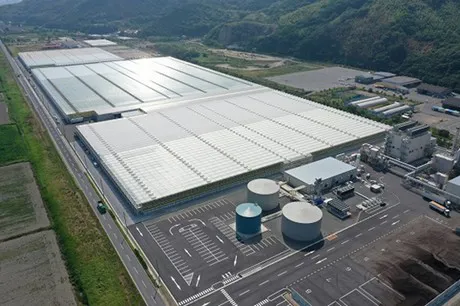
SARA was founded in 2016 by Takenobu Kobayashi, Tetsuo Wada & Taizo Sano. With SARA,the entrepreneurs want to offer vegetables to the Japanese market and even export if possible. Following a long career with Kagome, the biggest producer of tomato-based products in Japan, Taizo Sano knows the tomato industry very well. Now he’s expanding into other products. “Peppers in Japan currently are being imported. The Japanese industry is small, but consumers prefer local-grown product”, Taizo explains. “Introducing this way of lettuce growing, on NFT and selling as living lettuce, is an innovation to the market”, he says.
SARA is short for Smart Agribusiness Research & Alliance, and with the new greenhouse they sure live up to their name.
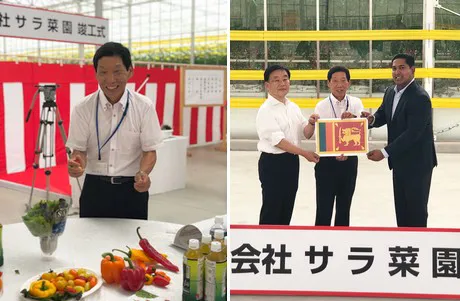
Cherry tomatoes, snack peppers on coco substrate and lettuce on moving NFT
In the 128,269 m² greenhouse, cherry tomatoes, snack peppers on coco substrate and lettuce on moving NFT will be grown. “In our farm, labour is an important part of our cost price and also one of the biggest challenges in the industry, so robotisation is of high importance, and we’ve automated the lettuce growing system as much as possible. In the system the water is cooled and enriched with nano bubbles later on - making the growing system one of the most advanced green production systems in the world”, Taizo shows. The moving NFT system is supplied by GPS (Green Product Systems) and is currently one of only two of these systems in semi-closed greenhouse up and running in the world. The lettuce will be sold as living lettuce, with the roots attached to it.
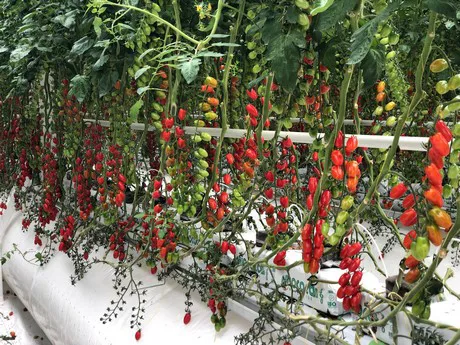
For the tomato greenhouse clear glass was selected, whereas the lettuce and pepper plants are growing under Smartglass: an etched variant wherein the dispersion/scattering of light adapts to the angle of the incoming light. “Energy is one of the major costs of our business”, says Taizo. “Okayama Prefecture, where we’re based, is known as the land of sunshine. Thanks to this natural light of about 2,100 hours per year, we can grow year round without artificial light, and we want to make the most of the light available.”
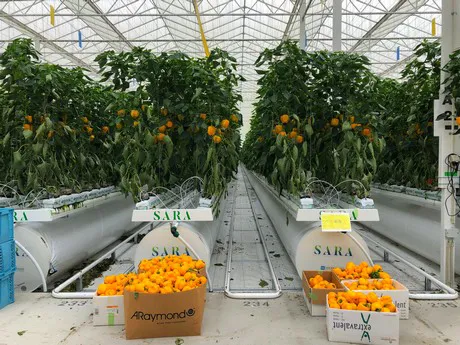
The greenhouse is fully designed for the optimum use of natural light. “The structure is very slim, to get the most light in. It’s completely powder coated and one of the lightest ones available in Asian countries nowadays.” As demanded in the Japanese industry, the project is also earthquake resistant.
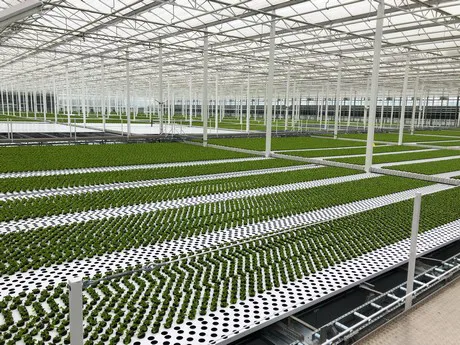
RIOCOCO Coir Growing Medium
The tomato and pepper plants are growing on Riococo grow bags - something that Taizo has been doing for over 15 years by now. “We want to grow premium vegetables year round. The Japanese consumers are willing to buy these products as well, since they trust our quality. We have the same trust in our suppliers and ever since we’ve switched to Riococo grow bags, I’ve never gone back”, he says. The same goes for other partners: SARA is in it for the long term. Also Richard Billekens, who has extensive knowledge and experience with Riococo is working as a visiting consultant for this project .

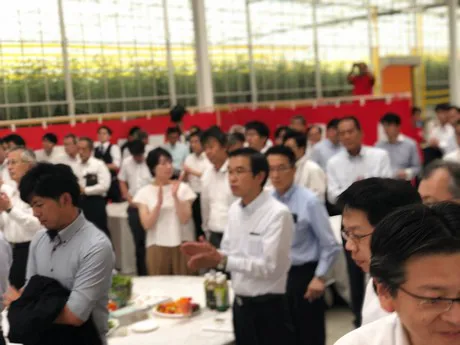
Technical facilities
The greenhouse is built by Van der Hoeven and automated by Hoogendoorn. “They did some serious calculating and super engineering”, Taizo says. “Climate control is of high importance. The temperature at our facility can go up to 37-38 degrees Celsius, combined with an 85 per cent humidity, meaning we have to do everything we can to avoid fungi and keep disease pressure low. Even in the nighttime in summer, the temperature remains over 30 degrees - so we need the right tools to work in these circumstances.”
Heat and energy
So what’s behind the glass, and how did the engineers make a system deal with this? The greenhouse itself is semi-closed: it works with a little over-pressure and using fans to spread the air and CO2, improves climate control and keeps insects out. Water is supplied by the city of Kasaoka and is disinfected by UV before being used in the farm.
The facility includes a biomass power plant running on wood chips and generating 10 MW electricity. The electricity will be sold to the grid mainly, whereas another 20 per cent will be used by the greenhouse. By doing so the company also reaches out to the Japanese society, where replacing nuclear energy is an important topic.

Air conditioning by steam
The heat generated from the system will be used in the greenhouse. Thanks to the installation of a gas cleaning system, the CO2 from the biomass power plant will also be used in the greenhouse, improving the plant growth. But most remarkable is how the steam generated by the boilers will be used for adiabatic cooling. Together with Van der Hoeven a new installation was created to do so: the Adiabatic cooling (ACo) and the Hygroscopic Adiabatic Cooling (HACO) climate control system. “The coolers run on the steam from the boilers. This way we can use all of the power we’re generating and grow top quality vegetables even in these hot and humid circumstances.”
To manage and control the greenhouse demand and the different levels of heat, cold and CO₂ the GEMS system was developed. This Energy Management System, made by Hitachi for the biomass powerplant and connected to the LetsGrow.com cloud platform. The Hoogendoorn iSii computer stores the important energy data into the cloud platform for optimizing the energy in the greenhouse.
The Hoogendoorn iSii process computer controls the ModulAir and HACO equipment and the greenhouse climate, CO₂ levels and the irrigation for the tomatoes, peppers and lettuce. The iSii system continuously keeps the GEMS system up to date on the required energy in the 3 different greenhouses.
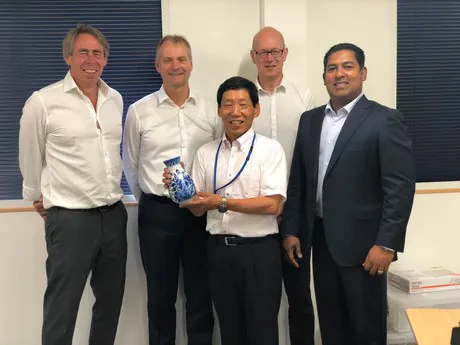
Peter Spaans with Van der Hoeven, Martin Helmich with Hoogendoorn & Shan Halamba with Riococo and of course in the middle mr Taizo Sano with Sara Farm
Growing support
The management of Sara hired two professional growers. Godfrey Dol is the expert in tomato crops and helps to manage and operate the tomatoes and peppers. Tim van Hissenhoven is well known as the lettuce specialist. A big part of their job is training the new Japanese growers. This team of Japanese growers is already well trained with the Hoogendoorn iSii computer, which is also available in the Japanese language. Both Godfrey and Tim are glad to work with the iSii computer which is easy to use and flexible. Also the modules of Letsgrow.com are installed for the important reports of Plant Empowerment. This give the growers more insight into information of the growing conditions in the different crops.
Many different parties worked together for this project, this unique combination of specialist forces, resulted in a top notch greenhouse. Both from the Japanese and Dutch side.
All partners fulfilled a specific role in this project; van der Hoeven; supplied the complete Modulair and HACO greenhouse project. Daisen worked on local project management, construction and ground work, and Takuma supplied the complete Biomass powerplant. Patron supplied the technical installation and irrigation, Hitachi was supplier of the GEMS system for the Biomass powerplant. Hoogendoorn supplied the automation (iSii process computer) and cloud platform LetsGrow.com for data-analyse and Plant Empowerment purposes.
For more information:
Sara Farm
Mr. Taizo Sano
taizo.sano@sarafarm.jp
